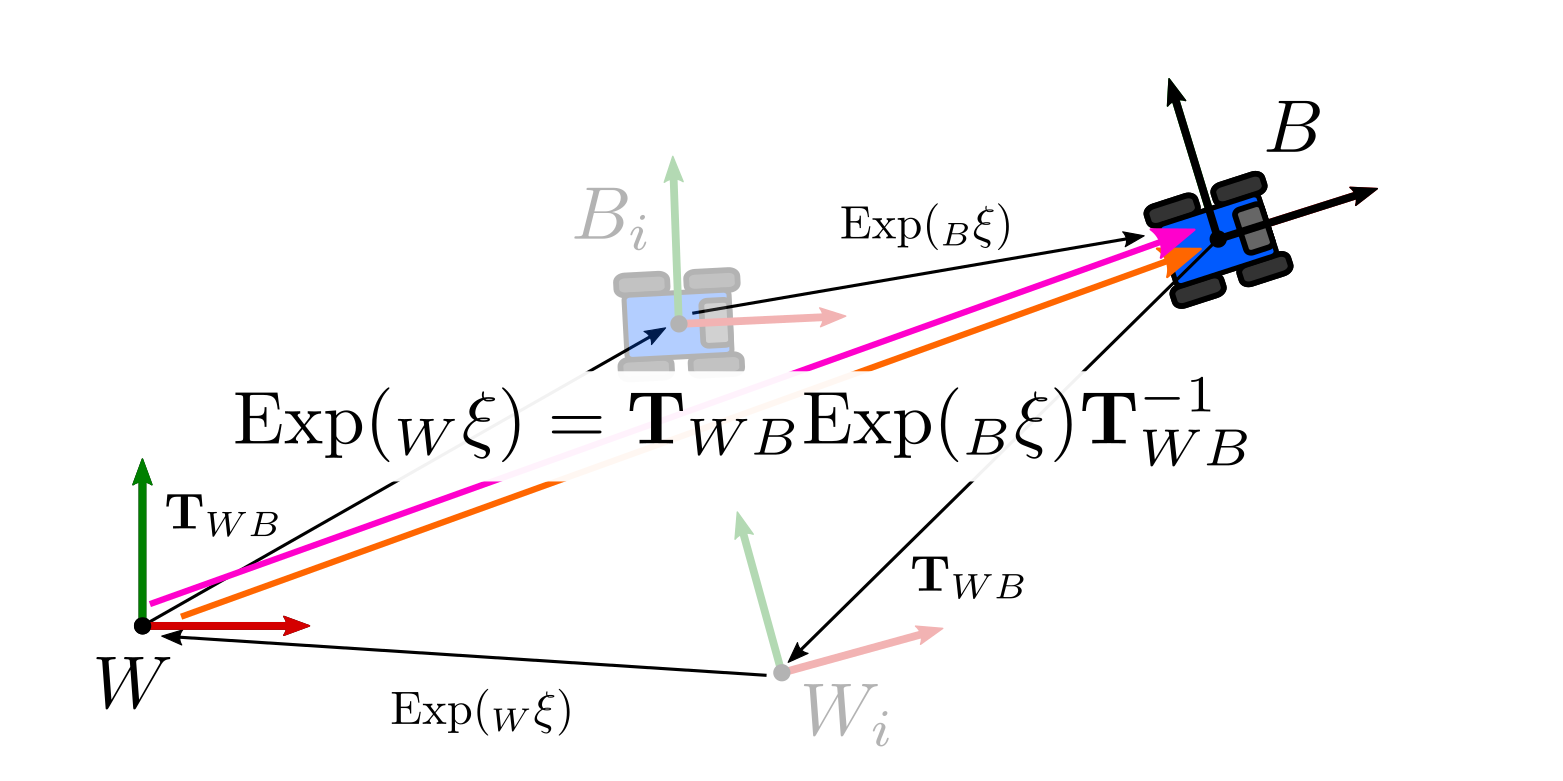Lie Group and Lie Algebra: SO(3), SE(3)
Last updated on November 26, 2023 pm
Overview [1]

Matrix Exponential & Logarithm
已知 \(A \in \mathbb{R}^{M \times M}\),
\[ \exp (\mathbf{A}) =\sum_{n=0}^{\infty} \frac{1}{n !} \mathbf{A}^{n} =\mathbf{1}+\mathbf{A}+\frac{1}{2 !} \mathbf{A}^{2}+\frac{1}{3 !} \mathbf{A}^{3}+\cdots \]
\[ \ln (\mathbf{A})=\sum_{n=1}^{\infty} \frac{(-1)^{n-1}}{n}(\mathbf{A}-\mathbf{1})^{n} \]
Lie Bracket
TODO
\(SU(2)\) and the Quaternions [2]
\[ R = C(q) \longrightarrow R^T = C(q^{-1}) \]
欧拉公式
\[ e^{ix} = \cos x + i \sin x \]

2D旋转
单位复数 可用来表示2D旋转。
\[ z = a + b\vec{i} = r (\cos \theta + \sin \theta \vec{i} ) = e^{\theta \vec{i}}, \quad r = ||z||=1 \]
3D旋转
单位四元数 才可表示3D旋转,四元数是复数的扩充,在表示旋转前需要进行 归一化。
\[ \mathbf{q} = \exp(\frac{\boldsymbol \phi}{2}) = \exp \left( \frac{\mathbf{u} \theta}{2} \right) = \cos \frac{\theta}{2} + \mathbf{u} \sin \frac{\theta}{2} = \begin{bmatrix} \cos \frac{\theta}{2} \\ \mathbf{u} \sin \frac{\theta}{2} \end{bmatrix} \quad s.t. \quad ||\mathbf{q}||_2 = 1 \]
当 \(\theta\) 很小时,一阶泰勒展开,可以近似表达为
\[ \mathbf{q} = \exp({\frac{\mathbf{u}\theta}{2}}) \approx 1 + \frac{\mathbf{u}\theta}{2} = \begin{bmatrix} 1 \\ \frac{\mathbf{u}\theta}{2} \end{bmatrix} = \begin{bmatrix} 1 \\ \frac{\boldsymbol{\phi}}{2} \end{bmatrix} \]
四元数可以在 保证效率 的同时,减小矩阵1/4的内存占有量,同时又能 避免欧拉角的万向锁问题。
Hamilton & JPL 四元数

\(SO(3)\)
Lie Group \(SO(3)\)
\[ SO(3) = \Bigg\{ \mathbf{R} \in \mathbb{R}^{3 \times 3} \Bigg| \mathbf{RR}^T = \mathbf{I}, det(\mathbf{R}) = 1 \Bigg\} \]
Lie Algebra \(\mathfrak{so}(3)\)
\[ \mathfrak{so}(3) = \Bigg\{ \boldsymbol{\Phi} = \boldsymbol{\phi}^{\wedge} \in \mathbb{R}^{3 \times 3} \Bigg| \boldsymbol{\phi} \in \mathbb{R}^3 \Bigg\} \]
where
\[ \boldsymbol{\phi}^{\wedge} = \begin{bmatrix} \phi_1 \\ \phi_2 \\ \phi_3 \end{bmatrix}^{\wedge} = \begin{bmatrix} 0 & -\phi_3 & \phi_2 \\ \phi_3 & 0 & -\phi_1 \\ -\phi_2 & \phi_1 & 0 \end{bmatrix} \in \mathbb{R}^{3 \times 3} \]
Infinitesimal Rotations
the base of \(\mathfrak{so}(3)\) are three skew symmetric matrices, each corresponding to infinitesimal rotations along each axis
\[ \mathbf{G}_{1}^{\mathfrak{s o}(3)}=\mathbf{e}_{1}^{\wedge}=\left(\begin{array}{ccc} 0 & 0 & 0 \\ 0 & 0 & -1 \\ 0 & 1 & 0 \end{array}\right) \quad \mathbf{e}_{1}=\left[\begin{array}{l} 1 \\ 0 \\ 0 \end{array}\right] \]
\[ \mathbf{G}_{2}^{\mathfrak{s o}(\mathbf{3})}=\mathbf{e}_{2}^{\wedge}=\left(\begin{array}{ccc} 0 & 0 & 1 \\ 0 & 0 & 0 \\ -1 & 0 & 0 \end{array}\right) \quad \mathbf{e}_{2}=\left[\begin{array}{l} 0 \\ 1 \\ 0 \end{array}\right] \]
\[ \mathbf{G}_{3}^{\mathfrak{s o}(3)}=\mathbf{e}_{3}^{\wedge}=\left(\begin{array}{ccc} 0 & -1 & 0 \\ 1 & 0 & 0 \\ 0 & 0 & 0 \end{array}\right) \quad \mathbf{e}_{3}=\left[\begin{array}{l} 0 \\ 0 \\ 1 \end{array}\right] \]
then the \(\mathfrak{so}\)(3)
\[ \mathfrak{s o}(3)=\left\{\mathbf{G}_{\mathbf{i}}^{\mathfrak{s o}(\mathbf{3})}\right\}_{i=1,2,3} \]
映射
指数映射
\[ \begin{aligned} \mathbf{R} &= \exp(\boldsymbol{\phi}^{\wedge}) \\ &= \mathbf{I} + \boldsymbol{\phi}^{\wedge} \mathbf{J}_l \quad \text{???} \end{aligned} \]
当 \(\|\phi\|\) 比较小时,一阶泰勒近似
\[ \mathbf{R} \approx \mathbf{I} + \boldsymbol{\phi}^{\wedge} \]
对数映射
\[ \boldsymbol{\phi} = \log(\mathbf{R})^{\vee} \]
\(SE(3)\)
Lie Group \(SE(3)\)
\[ SE(3) = \Bigg\{ \mathbf{T} = \begin{bmatrix} \mathbf{R} & \mathbf{t} \\ \mathbf{0}^T & 1 \end{bmatrix} \in \mathbb{R}^{4 \times 4} \Bigg| \mathbf{R} \in SO(3), \mathbf{t} \in \mathbb{R}^{3} \Bigg\} \]
Lie Algebra \(\mathfrak{se}(3)\)
\[ \mathfrak{se}(3) = \Bigg\{ \boldsymbol{\Xi} = \boldsymbol{\xi}^{\wedge} \in \mathbb{R}^{4 \times 4} \Bigg| \boldsymbol{\xi} \in \mathbb{R}^6 \Bigg\} \]
where
\[ \boldsymbol{\xi}^{\wedge} = \begin{bmatrix} \boldsymbol{\rho} \\ \boldsymbol{\phi} \end{bmatrix}^{\wedge} = \begin{bmatrix} \boldsymbol{\phi}^{\wedge} & \boldsymbol{\rho} \\ \mathbf{0}^T, & 0 \end{bmatrix} \in \mathbb{R}^{4 \times 4}, \quad \boldsymbol{\rho},\boldsymbol{\phi} \in \mathbb{R}^3 \]
The infinitesimal generators of SE(3)
the base of \(\mathfrak{se}(3)\) are these six 4×4 matrices, each corresponding to either infinitesimal rotations or infinitesimal translations along each axis
\[ \mathbf{G}_{\{\mathbf{1 , 2 , 3}\}}^{\mathfrak{s e}(3)} =\left(\begin{array}{c|c} & 0 \\ \mathbf{G}_{\{\mathbf{1}, \mathbf{2}, \mathbf{3}\}}^{\mathfrak{s o}(3)} & 0 \\ & 0 \\ \hline 0 & 0 \end{array}\right) \]
\[ \mathbf{G}_{4}^{\mathfrak{s c}(3)} =\left(\begin{array}{c|c} & 1 \\ \mathbf{0}_{3 \times 3} & 0 \\ & 0 \\ \hline 0 & 0 \end{array}\right) \quad \quad \mathbf{G}_{5}^{\mathfrak{s c}(3)}=\left(\begin{array}{c|c} & 0 \\ \mathbf{0}_{3 \times 3} & 1 \\ & 0 \\ \hline 0 & 0 \end{array}\right) \quad \quad \mathbf{G}_{6}^{\mathfrak{s c}(3)}=\left(\begin{array}{c|c} & 0 \\ \mathbf{0}_{3 \times 3} & 0 \\ & 1 \\ \hline 0 & 0 \end{array}\right) \]
then the \(\mathfrak{se}(3)\)
\[ \mathfrak{s e}(3)=\left\{\mathbf{G}_{\mathbf{i}}^{\mathfrak{s e}(3)}\right\}_{i=1 \ldots 6} \]
so
\[ \xi^\wedge = \sum_{i=1}^6 \xi(i) \cdot G_i \]
1 | |
Jacobian
to convert the translation component of pose in \(\mathfrak{se}(3)\) into the translation component of pose in \(SE(3)\) through
\[ \mathbf{t}=\mathbf{J}_l \boldsymbol{\rho} \in \mathbb{R}^{3}, \quad \mathbf{J}_l=\sum_{n=0}^{\infty} \frac{1}{(n+1) !}\left(\phi^{\wedge}\right)^{n} \]
映射
指数映射
\[ \mathbf{T} = \exp(\boldsymbol{\xi}^{\wedge}) \]
对数映射
\[ \boldsymbol{\xi} = \log(\mathbf{T})^{\vee} \]
Adjoints
Adjoint action of SE(3)
- https://gtsam.org/2021/02/23/uncertainties-part3.html

上图用伴随表示:
\[ \exp(\xi_w^{\wedge}) = T_{wb} \cdot \exp(\xi_b^{\wedge}) \cdot T_{wb}^{-1} = \exp((\mathtt{Adj}_{T_{wb}} \cdot \xi_b)^{\wedge}) \]
with the key property of exponential map
\[ \exp(T \xi^\wedge T^{-1}) = T \cdot \exp(\xi^\wedge) \cdot T^{-1} \]
we can get
\[ T \xi^\wedge T^{-1} = (\mathtt{Adj}_{T} \cdot \xi)^{\wedge} \]
so, for \(SO(3)\)
\[ R \phi^{\wedge} R^T = (R \phi)^{\wedge} \]
同一刚体中不同坐标系姿态变换的相互表示
以带有IMU的相机模组为例,已知 IMU(坐标系)本身的姿态变换 \(\mathbf{T}^{B}\) 和 同一模组中Camera到IMU(Body)的坐标系变换 \(\mathbf{T}_{BC}\),则 该Camera(坐标系)本身的姿态变换为:
\[ {}_C\mathbf{T} = \mathbf{T}_{BC} \cdot \mathbf{T}^{B} \cdot \mathbf{T}_{BC}^{-1} \]
因为上面的变换都是 坐标系的变换,所以矩阵相乘 从左到右,即 矩阵右乘

Exponential Map on \(SE(3)\)

1 | |
output:
1 | |
Baker-Campbell-Hausdorff (BCH)
Properties
\[ \exp((\phi + \delta \phi)^{\wedge}) \approx \exp((J_l \delta \phi)^{\wedge}) \cdot \exp({\phi}^{\wedge}) = \exp((J_l \delta \phi)^{\wedge}) \cdot R \]
\[ \exp((\phi + \delta \phi)^{\wedge}) \approx \exp({\phi}^{\wedge}) \cdot \exp((J_r \delta \phi)^{\wedge}) = R \cdot \exp((J_r \delta \phi)^{\wedge}) \]
where
\[ J_l = J_l (\phi), \quad J_r = J_r (\phi) \]
and
\[ \boldsymbol{J}_{l}=\boldsymbol{J}=\frac{\sin \phi}{\phi} \boldsymbol{I}+\left(1-\frac{\sin \phi}{\phi}\right) \boldsymbol{a} \boldsymbol{a}^{T}+\frac{1-\cos \phi}{\phi} \boldsymbol{a}^{\wedge} \]
\[ \boldsymbol{J}_{r}=\boldsymbol{J}=\frac{\sin \phi}{\phi} \boldsymbol{I}+\left(1-\frac{\sin \phi}{\phi}\right) \boldsymbol{a} \boldsymbol{a}^{T}-\frac{1-\cos \phi}{\phi} \boldsymbol{a}^{\wedge} \]
so
\[ J_l (-\phi) = J_r (\phi) \]
当 \(\phi\) 很小时
\[ J_l \approx I, \quad J_r \approx I \]
Rotations
The BCH formula
\[ \begin{aligned} \ln \left(\mathbf{C}_{1} \mathbf{C}_{2}\right)^{\vee}=\ln (\exp (&\left.\left.\phi_{1}^{\wedge}\right) \exp \left(\phi_{2}^{\wedge}\right)\right)^{\vee} \\ & \approx\left\{\begin{array}{ll} \mathbf{J}_{\ell}\left(\phi_{2}\right)^{-1} \phi_{1}+\phi_{2} & \text { if } \phi_{1} \text { small } \\ \phi_{1}+\mathbf{J}_{r}\left(\phi_{1}\right)^{-1} \phi_{2} & \text { if } \phi_{2} \text { small } \end{array},\right. \end{aligned} \]
In Lie group theory, \(J_r\) and \(J_l\) are referred to as the right and left Jacobians of \(SO(3)\), respectively.
Libs
- Sophus
- manif: A small header-only library for Lie theory